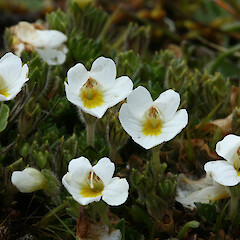Euphrasia townsonii
Common name
eyebright
Family
Orobanchaceae
Flora category
Vascular – Native
Endemic taxon
Yes
Endemic genus
No
Endemic family
No
Structural class
Herbs - Dicotyledons other than Composites
NVS code
The National Vegetation Survey (NVS) Databank is a physical archive and electronic databank containing records of over 94,000 vegetation survey plots - including data from over 19,000 permanent plots. NVS maintains a standard set of species code abbreviations that correspond to standard scientific plant names from the Ngä Tipu o Aotearoa - New Zealand Plants database.
EUPTOW
Current conservation status
The conservation status of all known New Zealand vascular plant taxa at the rank of species and below were reassessed in 2017 using the New Zealand Threat Classification System (NZTCS) – more information about this can be found on the NZTCS website. This report includes a statistical summary and brief notes on changes since 2012 and replaces all previous NZTCS lists for vascular plants.
Please note, threat classifications are often suggested by authors when publications fall between NZTCS assessment periods – an interim threat classification status has not been assessed by the NZTCS panel.
- Conservation status of New Zealand indigenous vascular plants, 2017 . 2018. Peter J. de Lange, Jeremy R. Rolfe, John W. Barkla, Shannel P. Courtney, Paul D. Champion, Leon R. Perrie, Sarah M. Beadel, Kerry A. Ford, Ilse Breitwieser, Ines Schönberger, Rowan Hindmarsh-Walls, Peter B. Heenan and Kate Ladley. Department of Conservation. Source: NZTCS and licensed by DOC for reuse under the Creative Commons Attribution 4.0 International licence.
2017 | Not Threatened
Previous conservation statuses
2012 | Not Threatened
2009 | Not Threatened
2004 | Not Threatened
Distribution
Endemic. South Island, Mountains of north-west Nelson to Paparoa Range and St Arnaud Mountains.
Habitat
Found at 500 – 1500m a.s.l. usually in damp and peaty ground.
Detailed description
Slender tufted perennial herb sometimes with stout woody stock; stems slender, much branched and rooting at nodes, branches erect, 50-150 mm tall, slender to filiform, usually densely pubescent with lax flattened white hairs. Leaves sessile, usually rather distant, 4-10 (-15) x 2-4 (-7) mm, narrow to ovate-rhomboid with 1-2 pairs of narrow acute teeth and large triangular acute terminal lobe, cuneate at base, glabrous or with sparse glandular or non-glandular hairs, margins thickened and revolute. Flowers few towards the tips of the branches on slender straight pedicels 5-20 mm long, usually distinctly longer than leaves; calyx and pedicels densely pilose with flattened white hairs and long glandular hairs. Calyx 5-8 mm long, approximately evenly divided 1/3-1/2 way; lobes lanceolate to triangular, acute, margins and midribs thickened and reddish. Corolla white, (10-) 15-20 mm long and diameter; tube much longer than calyx; lobes of lower lip 4-9 mm wide, usually deeply emarginate, of upper lip 2-5 mm wide, entire to emarginate. Anthers golden yellow, marginal hairs numerous, awns usually very unequal, stout. Capsule more or less equal to calyx or much shorter, 3-7 x 2.5-4 mm, broad-oblong to obovate or almost suborbicular, glabrous or nearly so; seeds 8-10 per locule, 1-1.5 mm long.
Similar taxa
Small forms could be mistaken with Euphrasia revoluta form which it can be distinguished by the leaves having 2 pairs of relatively large lateral teeth. The calyx of E. townsonii has glandular hairs present, compared to E. revoluta being glabrous or having non-glandular pubescent hairs.
Flowering
November – February (-April).
Flower colours
White, Yellow
Fruiting
January – February (-April).
Life cycle
Seeds is dispersed by wind and possibly water and ballistic projection (Thorsen et al., 2009).
Etymology
euphrasia: Eye-medicine
townsonii: Honours William L. Townson (1855-1926)
TAXONOMIC NOTES
Variable in the size and shape of the leaves and size of the flowers. Small forms with narrow-rhomboid leaves up to 5 x 3 mm with only 1 pair of small lateral teeth resemble E. revoluta closely, especially unusually short-pedicelled plants such as occur on Mount Robert, but the most robust forms with upper leaves broadly ovate-rhomboid, up to 15 x 7 mm, and with 2 pairs of large lateral teeth are very different. On Mount Arthur and Mount Peel occur dwarf tufted forms only approximately 20 mm high but with flowers and capsules still conspicuous above the imbricate leaves on pedicels 10-15 mm long.
Attribution
Fact sheet prepared for NZPCN by M.D. Ward (11 November 2020) Description adapted from Allan (1961).
References and further reading
Allan, H. H. 1961. Flora of New Zealand. Volume 1. Wellington: Government Printer. Pages 854-855.
Thorsen, M. J.; Dickinson, K. J. M.; Seddon, P. J. 2009. Seed dispersal systems in the New Zealand flora. Perspectives in Plant Ecology, Evolution and Systematics 11: 285-309


